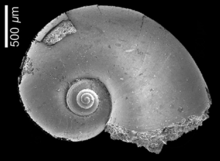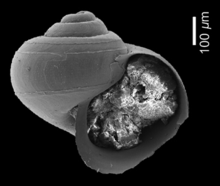Protatlanta souleyeti
| Protatlanta souleyeti Temporal range: Pliocene-Recent[1] | |
|---|---|
 | |
| apical view of the shell of Protatlanta souleyeti from the Pliocene of Philippines | |
| Scientific classification | |
| Kingdom: | Animalia |
| Phylum: | Mollusca |
| Class: | Gastropoda |
| (unranked): | clade Caenogastropoda clade Hypsogastropoda clade Littorinimorpha |
| Superfamily: | Pterotracheoidea |
| Family: | Atlantidae |
| Genus: | Protatlanta |
| Species: | P. souleyeti |
| Binomial name | |
| Protatlanta souleyeti (E. A. Smith, 1888)[2] | |
| Synonyms | |
|
Atlanta souleyeti Smith, 1888 | |
Protatlanta souleyeti is a species of sea snail, a holoplanktonic marine gastropod mollusk in the family Atlantidae.[3]
Protatlanta souleyeti is the type species on the genus Protatlanta.[1] It is considered to be the only Recent species on the genus.[1]
The specific name souleyeti is in honor of French malacologist Louis François Auguste Souleyet.

Description
The maximum recorded shell length is 2 mm.[4]
Some of the fossil specimens preserve a pinkish colour of the larval shells.[1] The protoconch is naticoid in shape and has approximately 3¼ whorls.[1] Most specimens have two thin spirals above the periphery, visible in apical view, and a third such spiral below the periphery, which separates the base of the protoconch and becomes covered by subsequent whorls.[1] The described ornament can be fairly constant, but some specimens were found in which these three spirals are lacking.[1] Richter (1968, p. 17, fig. 6c) described Recent larval shells from the Gulf of Naples as smooth.[1] For Recent material from near Hawaii, Seapy (1990, p. 114, fig. 4A-D) also stated that the first whorls are smooth.[1] But Batten & Dumont (1976, figs. 39-41) and Richter & Seapy (1999, p. 633, fig. 5A) and Janssen (2007)[1] have described two protoconch morphologies.[1] On the teleoconch whorls, the peripheral belt on which the conchiolin keel was attached is very clear.[1] Growth lines are strongly bent backward on this belt, indicating the presence of a deep sinus on the apertural margin.[1] A very faint spiral striation is visible all over the adult shell surface.[1]
Distribution
The first fossil specimens of Protatlanta souleyeti from Cainozoic has been found from Pliocene in Anda, Pangasinan, Luzon, Philippines in 2001 (published in 2007).[1]
Habitat
Minimum recorded depth is 0 m.[4] Maximum recorded depth is 0 m.[4]
References
This article incorporates CC-BY-3.0 text from the reference [1]
- 1 2 3 4 5 6 7 8 9 10 11 12 13 14 15 16 Janssen A. W. (2007). "Holoplanktonic Mollusca (Gastropoda: Pterotracheoidea, Janthinoidea, Thecosomata and Gymnosomata) from the Pliocene of Pangasinan (Luzon, Philippines)". Scripta Geologica. 135.
- ↑ Smith E. A. (1888). "Report on the marine Mollusca collected by H.M.S. Challenger during the years 1873-1876". Challenger Reports 72(23): 1-51. page 43.
- ↑ Protatlanta souleyeti (Smith E.A., 1888). Gofas, S. (2009). Protatlanta souleyeti (Smith E.A., 1888). In: Bouchet, P.; Gofas, S.; Rosenberg, G. (2009) World Marine Mollusca database. Accessed through: World Register of Marine Species at http://www.marinespecies.org/aphia.php?p=taxdetails&id=138840 on 14 August 2010.
- 1 2 3 Welch J. J. (2010). "The "Island Rule" and Deep-Sea Gastropods: Re-Examining the Evidence". PLoS ONE 5(1): e8776. doi:10.1371/journal.pone.0008776.